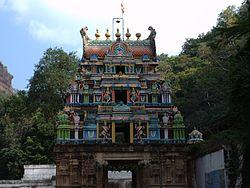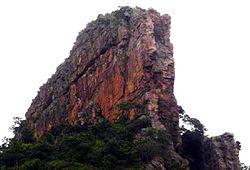Ahobilam | |
|---|---|
Town | |
 Upper Ahobilam temple Gopuram | |
| Coordinates: 15°08′00″N 78°43′00″E / 15.1333°N 78.7167°E | |
| Country | |
| State | Andhra Pradesh |
| District | Kurnool |
| Elevation | 327 m (1,073 ft) |
| Population | |
| • Total | 3,732 |
| Languages | |
| • Official | Telugu |
| Time zone | UTC+5:30 (IST) |
| Vehicle registration | AP |
| Website | http://ahobilamtemple.com |
Ahobilam is a town and holy site in the Allagadda mandal of Kurnool district in the Indian state of Andhra Pradesh.[1] It is surrounded by picturesque hills of the Eastern Ghats with several mountain hills and gorges. It is the centre of worship of Narasimha, the lion-headed avatar of Vishnu, to whom the nine Hindu temples and other shrines all dedicated. The main village and a temple complex are at Lower Ahobilam. Upper Ahobilam, about 8 kilometres to the east, has more temples in a steep gorge.[2]
The temple consists of nine shrines to Narasimha, located around a 5 km circle. In addition to the nine shrines, there is a temple for Prahaladavarada Varadhan in the foothills of the mountain. Due to security reasons and the difficulty in performing daily worship, many of the utsava vigrahas of the nine shrines are kept in this temple. To visit the entire group still involves some relatively arduous walking.
The main Narashima temples at each site were built or expanded by the emperors of Vijayanagara in the 15th and 16th centuries, then sacked by the Mughals in 1578, then restored and expanded at various times, up to the present day. As they stand, they are a mixture of work from all these periods.[3]
History
Ahobilam is traditionally regarded as the place where Vishnu in the form of Narasimha killed Hiranyakashipu in order to save his child devotee Prahlada. Story goes on like this, when Jaya and Vijaya was harassing and blocking the seventh gateway for the four kumaras to enter, they received a curse from them that they would be born as demons on Earth 3 times but still related to each other. Their first birth was (Jaya as) Hiranyakashipu and (Vijaya as) Hiranyaksha, to Kashyapa and Diti, after the demons were tricked by devas from drinking the Amrita (Nectar of Immortality). Diti originally asked a boon from her husband Kashyapa to bless her with two strong sons who could slay Indra and other devas. Kashyapa being rightful husband, granted that boon from which Hiranyaksha and Hiranyakashipu were born.
The pillar out of which Lord Narasimha burst out open is called Ugra Stamba, and one can still find the so called Pillar in Ahobilam even today. Whole hill is obviously sthousand yearce Lord Narasimha himself wandered out there to protect his child devotee Prahalada. The time when this happened was in Satya Yuga, which was around million years ago.
The legend says that Lord Narasimha emerged from a pillar to save the child Prahalada from his father Hiranyakashipu's atrocities. The pillar he came out burst open is called Ugra Stamba, which one can see even today. The moment is represented in a number of murti in the various temples. Also, Garuda prayed for a vision of Narasimha in the form of Avathara, to fulfil his wish, and settled in nine forms across the hills in Ahobilam.
Geography
Ahobilam is located at 15°08′00″N 78°43′00″E / 15.1333°N 78.7167°E.[4] It is located in Nallamala Forest, along the Eastern Ghats.[5]
Notes
- ^ "Book on Ahobilam temple released". The Hindu. Special Correspondent. 6 March 2019. ISSN 0971-751X. Retrieved 17 May 2019.
- ^ Michell, 330
- ^ Michell, 330
- ^ "redirect to /world/IN/02/Pedda_Ahobilam.html". fallingrain.com.
- ^ KUMAR, R. SANDEEP (9 September 2018). "Ahobilam: A journey into spirituality". Deccan Chronicle. Retrieved 17 May 2019.
References
- Blurton, T. Richard, Hindu Art, 1994, British Museum Press, ISBN 0 7141 1442 1
- Michell, George (1990), The Penguin Guide to the Monuments of India, Volume 1: Buddhist, Jain, Hindu, 1990, Penguin Books, ISBN 0140081445
.svg.gif)
